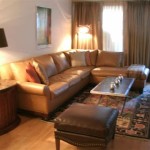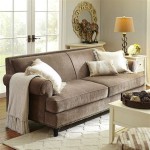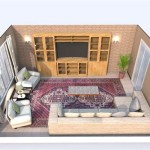Maximizing Space: Integrating Big Furniture in a Small Living Room
Successfully incorporating large furniture pieces into a small living room requires careful planning and a strategic approach to spatial design. The challenge lies in balancing comfort and functionality without overwhelming the limited available area. This necessitates a thorough understanding of scale, proportion, and the principles of visual perception. By employing specific techniques and prioritizing essential elements, it is possible to create a living room that feels both spacious and well-appointed, even with substantial furniture.
The initial step involves accurately measuring the living room's dimensions. This includes the length and width of the room, the height of the ceiling, and the placement of windows and doorways. These measurements are crucial for determining the maximum size of furniture pieces that can be accommodated without obstructing movement or natural light. A detailed floor plan, either drawn manually or created using online tools, can further assist in visualizing the layout and identifying potential problem areas.
Furthermore, understanding the room's primary function is essential. Is it primarily used for relaxation, entertainment, or social gatherings? Identifying the living room's purpose will inform the choice of furniture and its arrangement. For example, a living room primarily used for watching television may prioritize a large sofa and a well-positioned entertainment center, while a living room designed for socializing may benefit from a more open layout with comfortable seating arranged to facilitate conversation.
Prioritizing Furniture Selection
Choosing the right furniture is paramount when dealing with a small living room. Opting for multi-functional pieces can significantly maximize space and reduce clutter. A sofa bed, for instance, can serve as both a seating area and a guest bed, eliminating the need for a separate guest room. Similarly, an ottoman with hidden storage can provide additional seating and a convenient place to store blankets, pillows, or other items. Coffee tables with lift-top mechanisms can be used as dining tables or workstations, further enhancing functionality.
Scale is a critical factor in furniture selection. Oversized furniture can quickly overwhelm a small living room, making it feel cramped and uncomfortable. Instead, choose furniture that is proportionate to the size of the room. Consider sofas with slim armrests and low backs to minimize their visual bulk. Chairs with open frames and exposed legs create a sense of airiness and prevent the room from feeling too cluttered. Avoid bulky, heavily upholstered pieces that can dominate the space.
Color also plays a significant role in creating a sense of spaciousness. Light and neutral colors, such as white, beige, and gray, reflect light and make a room appear larger. Dark colors, on the other hand, absorb light and can make a room feel smaller and more enclosed. Consider using lighter shades for the walls, flooring, and larger furniture pieces to maximize the feeling of openness. Then, incorporate pops of color through accessories, such as throw pillows, rugs, and artwork, to add visual interest and personality.
Material choice also influences the perceived size and feel of the room. Glass and acrylic furniture can create a sense of transparency and lightness, making them ideal for small spaces. Mirrored surfaces can also be used strategically to reflect light and create the illusion of more space. Avoid heavy, opaque materials that can weigh down the room and make it feel smaller.
Strategic Furniture Arrangement
The arrangement of furniture is as important as the furniture itself. A well-thought-out layout can maximize space and create a comfortable and functional living area. Start by identifying the focal point of the room, such as a fireplace, a large window, or a television. Arrange the furniture around this focal point to create a balanced and visually appealing composition.
Avoid pushing all the furniture against the walls. This can create a boxed-in feeling and make the room appear smaller. Instead, float the furniture slightly away from the walls to create a sense of depth and dimension. This can be particularly effective with sofas and chairs. Leaving a small gap between the furniture and the walls allows light and air to circulate, making the room feel more open and inviting.
Creating clear pathways is essential for easy movement within the living room. Ensure that there is ample space to walk around the furniture without bumping into it. Avoid placing furniture in doorways or blocking access to windows. Consider using rugs to define different zones within the room, such as a seating area, a conversation area, or a reading nook.
Vertical space is often underutilized in small living rooms. Consider using tall bookshelves or wall-mounted cabinets to maximize storage without taking up valuable floor space. Hanging artwork or mirrors on the walls can also draw the eye upward and create a sense of height. Avoid cluttering the walls with too many small items, as this can make the room feel busy and overwhelming.
Optimizing Light and Minimizing Clutter
Light is a crucial element in creating a spacious and inviting living room. Maximize natural light by keeping windows clean and unobstructed. Avoid heavy curtains or blinds that can block sunlight. Instead, opt for sheer curtains or light-filtering shades that allow light to enter while providing privacy. Supplement natural light with artificial lighting, such as floor lamps, table lamps, and recessed lighting. Layered lighting can create a warm and inviting atmosphere and highlight different areas of the room.
Minimizing clutter is essential for maintaining a sense of spaciousness in a small living room. Regularly declutter the room and remove any unnecessary items. Store items that are not frequently used in storage containers or cabinets. Consider using vertical storage solutions, such as shelves and wall-mounted organizers, to maximize storage without taking up floor space. Avoid leaving items scattered on surfaces, as this can make the room feel disorganized and cramped.
Accessorizing thoughtfully can enhance the overall aesthetic of the living room without adding clutter. Choose a few statement pieces that complement the furniture and décor. Avoid over-accessorizing, as this can make the room feel busy and overwhelming. Consider using plants to add a touch of nature and freshness to the room. Plants can also help to purify the air and create a more relaxing atmosphere.
Maintenance is key to preserving the spacious feel of a small living room. Regularly clean the room to prevent dust and dirt from accumulating. Dust furniture, vacuum carpets, and wash windows to keep the room looking its best. Promptly repair any damage to furniture or fixtures to prevent them from becoming eyesores. A well-maintained living room will always feel more spacious and inviting.
Ultimately, integrating big furniture into a small living room is a balancing act. It requires careful consideration of each element, from the initial planning stages to the final touches. By prioritizing function, scale, and aesthetics, it is possible to create a living room that is both comfortable and visually appealing, regardless of its size.

How To Arrange Furniture In A Small Living Room The House

How To Use Full Scale Decor Make A Small Space Feel Bigger

51 Inspiring Small Living Rooms Using All Available Space

Can You Put Large Furniture In A Small Room

Living Room Ideas Oversized Furniture Colorado Style Home Furnishings

How To Arrange Furniture In A Small Living Room Setting For Four Interiors

Top 10 Ideas On How To Decorate A Small Living Room Decorilla Online Interior Design

Small Living Room Ideas To Maximize Space Create Style

How To Efficiently Arrange The Furniture In A Small Living Room

10 Tips For Styling Large Living Rooms Other Awkward Spaces The Inspired Room
See Also








